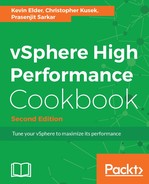The first step is to download the HCIBench software:
- Go to https://labs.vmware.com/flings/hcibench.
- Download the HCIBench<version>.ova file.
Now, deploy the controller VM and perform the following steps:
- Log in to vSphere Web Client.
- Navigate to the Hosts and Clusters view, then right-click on your cluster and select Deploy OVF Template.
- In the wizard, browse and select the HCIBench<version>.ova file we downloaded earlier. Click on Next.
- Enter the name of the new VM and select the desired datacenter. Click on Next.
- Select the desired host or cluster. Click on Next.
- Review the details and click on Next.
- Read the license agreement and click on Accept. Click on Next.
- Select thin provisioning for the disk format. Select the desired storage location. Click on Next.
- In the Select Networks screen, HCIBench will be accessed via the public network. Vdbench guests will be deployed and will require DHCP in the private network. Both Public Network and Private Network can be mapped to the same network if you like. Click on Next.
- In the Customize Template screen, expand the root credentials at the bottom and enter the root password. Click on Next.
- Review the configuration, then click on Finish.
The HCIBench VM will be deployed. Once this is done, power on the VM. When the VM is running, follow these steps to configure your test:
- Click on the HCIBench VM and find its IP address under the Summary tab:

- Go to http://<IP address>:8080.
- Log in with the root and the password specified during the deployment.
- You will be presented with a page with a large number of parameters:

- Enter the vCenter Hostname/IP, vCenter Username, and vCenter Password of the vCenter system where you want to run the tests.
- Enter the Datacenter Name, Cluster Name, and Network Name where the Vdbench guests will be deployed. The Network Name is optional and will default to the VM network if left blank.
- Click on the checkbox for Enable DHCP Service on the network if the mapped Private Network does not have a DHCP server already.
- Enter the datastore name that you will be testing against. If you enter multiple datastores, the Vdbench guests will be deployed evenly on the datastores.
- Click on the checkbox for Clear Read/Write Cache Before Each Testing if you are testing a vSAN datastore and want to clear the cache tier before the test.
- If you would like to specify the hosts where the guests will be deployed, click on the Deploy on Hosts checkbox and enter one or more hostnames.
- If you are testing against vSAN, check the Easy Run checkbox. If you are running this test against non-vSAN storage, leave this box unchecked.
- Enter the number of VMs to be deployed.
- Enter the number of data disks to be deployed on each guest VM.
- Enter the size of each data disk in GB.
- Click on Re-Use The Existing VMs If Possible if you have run the test previously and want to reuse the existing VMs.
- Give the test a name.
- Select an existing Vdbench parameter file or click on Generate to create one:

- The number of disks to test must match the number of data disks in the previous screen. Once you have generated the Vdbench parameter file, close the page, go back to the main page, and click on Refresh. Your parameter file will appear in the drop-down list:

- In the Prepare Virtual Disk Before Testing drop-down list, select Random if your storage has deduplication enabled. Otherwise, select Zero.
- Enter a value in the Testing Duration field if you want to override the elapsed value to the Vdbench parameter file.
- Check the Clean up VMs after testing checkbox if you want the guest VMs to be deleted after the test.
- Click on Download to download the Vdbench file from the Oracle website. Once it has been downloaded, click on Choose File to upload the ZIP file. Then, click on Upload Vdbench. This is a one-time operation, and these options will disappear after you upload the Vdbench file:

- Click on the Save Configuration button. Any issues will be reported so you can fix them.
- Click on the Validate button and fix any issues that are reported. If any issues are found, fix the issue, save the configuration, then run the validation again:

- Click on Test to start running the tests. The controller VM will connect to vCenter and deploy the test VMs:

In vCenter, you will see several tasks as the guest VMs are being created. Eventually, you will see the guest VMs in your inventory. They will be located in a new folder called vdb-<cluster name>-vms:

After the system has finished preparing the guest VMs and their disks, the testing will begin:

Once the test has finished, close the progress screen and click on the Result button to browse the results page. Open the folder with your test name, then open the text file to view the results. This will show IOPS, throughput, and latency of each datastore specified.
